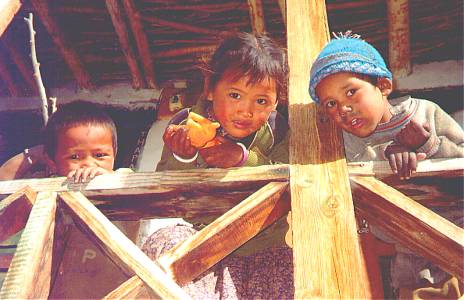
kids in Nako Village

kids in Nako Village
Bill and Bessie Too tell their tales of the Himalaya: Part Three—Tabo to
Rampur
Mandi, Himachal Pradesh, India
2 November 2002
Some days the Internet just doesn't work at all here in the hills. Even on a good day, it takes the patience of Job to send and receive e-mail!
Guidebooks really prove their worth in India, because other sources of information are poor or nonexistent. Only my guidebook mentioned that I'd need a permit to go near the India-Tibet border of upper Kinnaur. I got it in Kaza, taking just a couple of hours, two photos, and passport photocopies. Now Bessie Too and I were ready to enter our next region of the Indian Himalaya—Kinnaur.
There are certain sounds that a cyclist would rather not hear—the hiss of air, of course, and the snapping of steel. It was this latter sound that occurred on the otherwise tranquil ride down the Spiti Valley from Tabo. The saddle flew out from under me as the seatpost bolt snapped and various pieces of hardware bounced onto the asphalt. This had happened on Bessie Too's first ride in the Indian Himalaya six years ago, and I'd thought it a freak failure. Out came the duct tape, but the seat wobbled way too much and came loose. Bicycles are most unsuitable for riding without a seat! What to do? Then I remembered having a similar-sized bolt on the chain-riveting tool. It worked (for a couple days) and I was able to continue riding.
The Spiti River had the most beautiful transparent blue color—and I got some good photos of it as I wound through brown canyons below Tabo. An official checked my permit at Sumdo, close to the Tibet border. The Pare Chu River tumbles down from Tibet here, and the Spiti River makes a 90-degree turn to the south. A road branches off for Tibet, but only the military could use it. Despite India's long borders with China and several road connections, not a single crossing is open! Only one of the many trails to Tibet is open, and only for specially selected Indian pilgrims. The Indian government seems incapable of resolving its long-running border dispute with China, though the Chinese have indicated a willingness to negotiate.
On down the deep canyon of the Spiti River, I was now in Kinnaur. Famed as "celestial musicians," the Kinnauri consider themselves a group distinct from other Indians. I was able to hear their music later in the Hindu temple town of Sarahan. In the upper valley, most people follow Tibetan Buddhism, while those lower down follow a mix of Buddhism and Hinduism.
Meeting other cyclists had been a rare occasion, and I was surprised to meet a cycling couple from Germany. They were headed upriver to Spiti and would continue to Lahaul and over the Rohtang Pass to Manali. We traded information, including the crossing of the dreaded landslide zone just north of Yangthang Village. After climbing high up the hillside—most villages are far above the narrow confines of the lower gorge—I saw the massive cliffs of crumbling rock come into view. The road department seemed to have given up maintaining this one-km stretch of road. A cableway bypassed the ruined section of road, but carries only cargo. I loaded Bessie Too and bags onto the precarious-looking contraption, then watched her go whizzing across a deep gorge to the other side. No sooner had I started walking on the rock-strewn former road, than it started raining—stones! I ducked under an overhang, glad to have kept my cycling helmet on, and waited out the "storm." Rocks, much bigger this time, then began to break off a cliff up ahead, but stopped long enough for me to scurry by and reach safety. Bessie Too made it with just some small scratches.
I hoped to reach Nako, a very picturesque lakeside village of stone houses. The unpaved road proved slow going up its switchbacks, and darkness had fallen when I rolled up to a guesthouse. Next morning I wandered down to the little lake and explored the village's maze of narrow passageways. Poplar trees around the small lake were changing to gold, adding to the beauty of the scene. Views also took in high mountains all around and the deep Spiti Valley below.
The ride down from Nako was one of the best of the trip. I swooped through switchbacks and soared high above the river on sections of road carved into the cliffs. Finally, in the dark canyon recesses near Khab, I reached the banks of the Spiti River, here a milky blue-green from Tibetan glacial silt. At Khab, the gray waters of the Sutlej River roared in from Tibet, and the Spiti ceased to exist. I spent the night in Spello at a very basic lodge run by a Nepali. A workshop man gave me an old truck bolt that was a perfect fit for Bessie Too's seatpost!
On down the Sutlej, then a stiff climb to Kalpa (2960 m; 10,000 feet), a very pretty village surrounded by apple orchards. The apple harvest was in full swing with boxes of red and golden fruit being loaded onto trucks for their journeys across India. Directly across the valley stands the massive snow peak Kinner Kailash (6050 m; 20,000 feet) and its icy neighbors. Now I was in forested country. Most buildings have an earthquake-resistant stone and wood construction topped with a slate roof, and many structures have decorative woodcarvings. I found the best woodwork in a group of Hindu temples, which has an open sided gallery for musicians.
I descended sharp switchbacks to the banks of the Sutlej River and headed downstream a bit, then turned southeast up the Sangla Valley. Indian guidebooks describe the Sangla as one of the most beautiful of the Himalaya. I agreed, and found the valley a spectacular ride. The road climbs high on cliffs above the Baspa River to a little shrine to the Hindu goddess Durga. I stopped and had a chat with the sadhu, Shiv Nam Raja Boribabaji, who takes care of the shrine. He had built himself a tiny shelter of bricks between the road edge and a rock wall. Living just inches from passing trucks and cars didn't seem a likely place for a renunciate to live, but he was happy here. Late in the day I reached the market town of Sangla, in apple-growing country. The village of Kamru above has a spectacular setting on a ridge, where a multi-story fort-like temple dominates the village. Only priests are allowed inside, but I was able to visit the courtyard and see some of the exterior woodcarvings and shrines. The ride farther up the valley to road's end at Chitkul Village (3450 m; 11,400 feet) was pure joy. I wound through conifer forests, admired the sheer peaks and narrow valleys all around, and gazed out across the vast meadows beyond Chitkul.
A long ride down the Baspa/Sangla and Sutlej valleys, then a very stiff climb brought me to Sarahan (1920 m; 6,400 ft), famed for the twin towers of Bhimakali Temple. One tower, 800 years old, had become too fragile for regular use, so a similar one was built beside it in the 1920s. Unlike all the other temple towers I'd seen, this newer one was open to visitors, and I was able to climb up to the main floor that overhangs the lower part of the tower. Nothing to be seen on the first two levels, but the third has a shrine to Parvati, wife of Shiva, and the fourth and most important level houses an elaborately decorated group of images surrounding Bhimakali, is a local form of Kali.
Celebrations of the Dussehra Festival took place the next day, with groups of devotees parading local gods on palanquins from the Bhimakali Temple to the lawn of an old palace. The gods were assemblages of metal masks affixed to a triangular or cylindrical frame and topped by a "wig" of long black "hair." The gods liked to be gently bounced up and down as they were carried along. Musicians played celestial themes: oboe-like instruments carried the melody and were accompanied by a variety of drums. Mournful-sounding giant horns, straight or curved, sounded from time to time. Men and women danced in large circles, and a good time was had by all.
A scenic high road through villages, jungle, apple orchards, and conifers, followed by a long descent, led to Rampur on the Sutlej River. At 924 meters, I could enjoy lowland warmth for the first time on this ride.
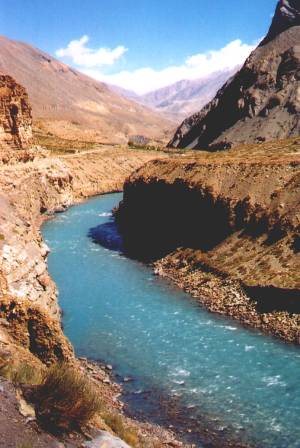 View
down the Spiti River below Tabo
View
down the Spiti River below Tabo
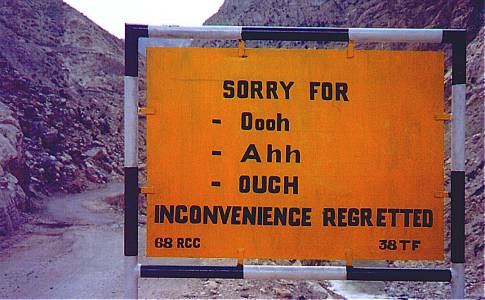
I've just descended into the dark depths of the canyon where the Spiti River joins
the Sutlej.
 In
this folksy wood carving at a Hindu temple in Kalpa,
In
this folksy wood carving at a Hindu temple in Kalpa,
the god Vishnu resides on a
snake while getting a foot massage.
Meanwhile, the creator god Brahma sprouts from
Vishnu's navel.
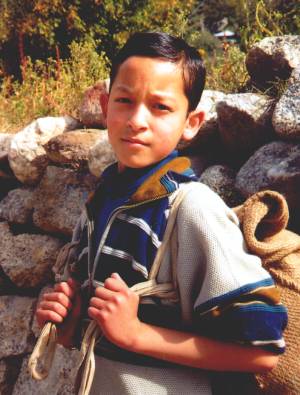 Kinnauri
boy from Kamru Village
Kinnauri
boy from Kamru Village
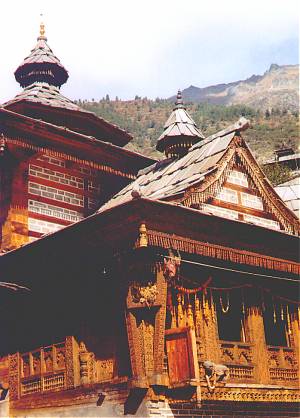
Kamru temples display intricate wood carving.
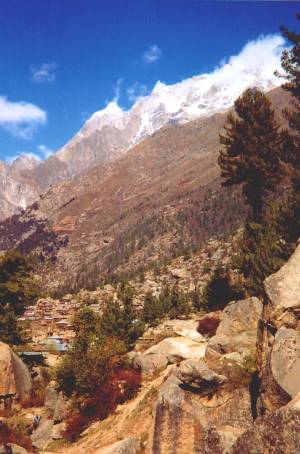
Rakchham Village in the Sangla Valley
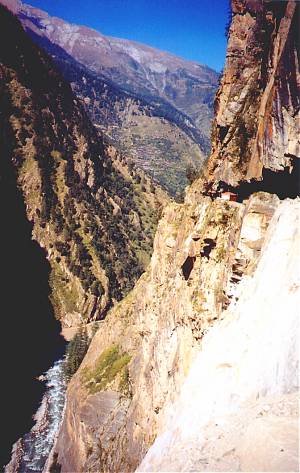
High above the Baspa River, the road slices across this cliff face.
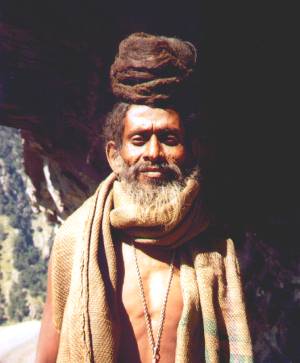
Shiv Nag Raja Boribabaji welcomes travelers who stopped to pay respects
at the
tiny Durga Mandir (previous photo). He seemed very happy living here.
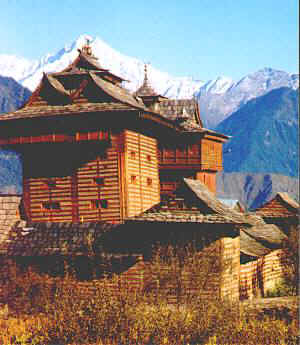
Bhimakali Temple.Sarahan, surrounded on all sides by
mountain ranges, lies
nearly 1000 meters above the Sutlej River.
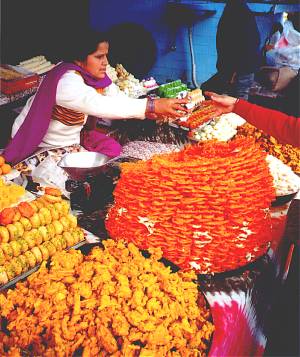 Festival
time in Sarahan—Indians love snacks, such as
Festival
time in Sarahan—Indians love snacks, such as
the pakora (veggies dipped in
batter, then fried) in the left foreground and
the bright orange jalebi (pretzels
fried, then soaked in sugar syrup) in the center.
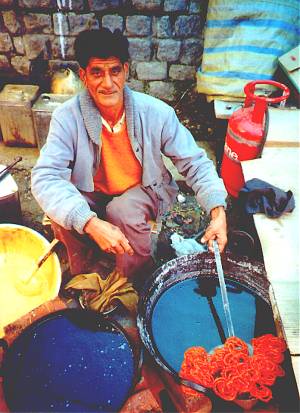 Jalebis-to-go
in Sarahan
Jalebis-to-go
in Sarahan
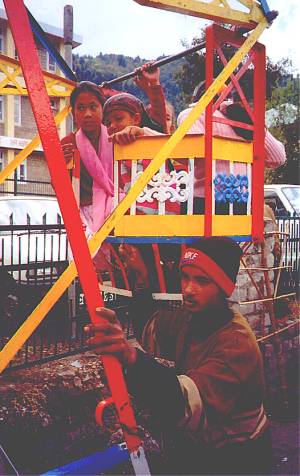
Human-powered Ferris wheels in Sarahan were a hit with the kids.
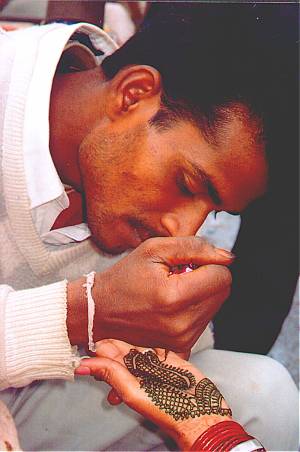 A
woman has her hand decorated with henna.
A
woman has her hand decorated with henna.
The artist squeezes out the mud-like henna,
which stains the skin a reddish-brown.
It's like a tattoo, but is painless and fades
away after several days.
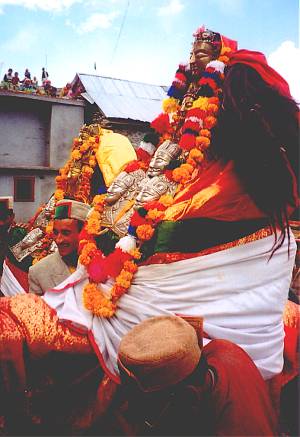 On
this day of the Dussehra Festival in Sarahan,
On
this day of the Dussehra Festival in Sarahan,
local gods travel from the main temple
to nearby shrine and palace,
where they're entertained by music and dances. Note
the traditional woolen caps worn by the men.
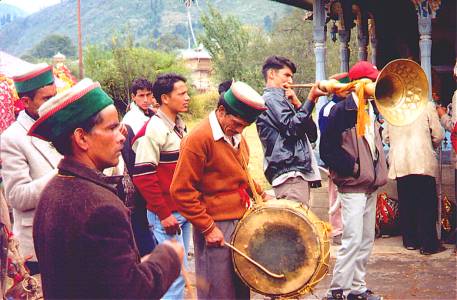
Kinnauri musicians playing traditional tunes for the gods.
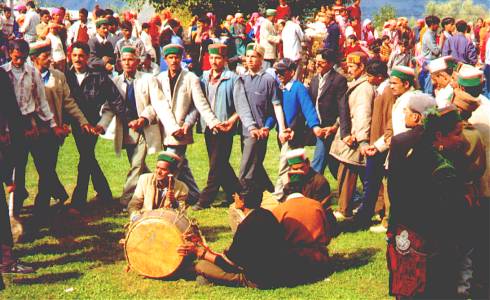
After the procession of the local gods arrived here on the palace grounds,
people
joined hands to dance in ever larger circles.
Next: Cycling from Rampur over the Jalori La to the Kullu Valley and Mandi